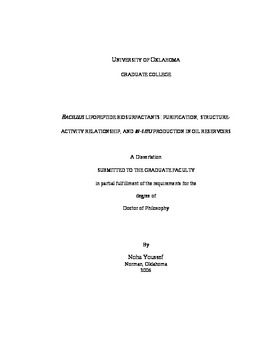| dc.contributor.advisor | McInerney, Michael J., | en_US |
| dc.contributor.author | Youssef, Noha. | en_US |
| dc.date.accessioned | 2013-08-16T12:20:27Z | |
| dc.date.available | 2013-08-16T12:20:27Z | |
| dc.date.issued | 2006 | en_US |
| dc.identifier.uri | https://hdl.handle.net/11244/1124 | |
| dc.description.abstract | Alternatively, biosurfactant activity can be manipulated by formulation of biosurfactant mixtures with different properties. The efficacy of biosurfactants from individual strains, and mixtures of biosurfactants from different strains with and without synthetic surfactants was tested for enhanced interfacial activity. To design (bio)surfactant formulations effective in lowering IFT, information about both the bio/surfactant structure and the nature of targeted non-aqueous phase liquids (NAPL) was required. The IFT against toluene was lowered by using lipopeptide biosurfactants with a heterogeneous fatty acid composition or by using mixtures of lipopeptide and rhamnolipid biosurfactants. Conversely, the IFT against hydrophobic NAPL was lowered by mixing lipopeptide biosurfactants with a more hydrophobic synthetic surfactants. | en_US |
| dc.description.abstract | To investigate the feasibility of microbially enhanced oil recovery (MEOR), we conducted a controlled field experiment in a limestone formation. The feasibility of biosurfactant production in-situ by two biosurfactant-producing Bacillus species was studied. In situ metabolism and biosurfactant production were evident. The lipopeptide biosurfactant was produced at concentrations that far exceeded that needed to mobilize substantial amounts of entrapped oil. The data demonstrate the technical feasibility and cost-effectiveness of microbial processes for oil recovery and the success of inoculation. | en_US |
| dc.description.abstract | Biosurfactants produced by several Bacillus strains had different activities. In order to relate biosurfactant structural differences to activity, eight lipopeptide biosurfactants with different specific activities produced by various Bacillus species were purified by a new protocol. The amino acid composition of the 8 lipopeptides was the same (Glu/Gln: Asp/Asn: Val: Leu; 1:1:1:4), but the fatty acid composition differed. Multiple regression analysis showed that the specific biosurfactant activity depended on the ratios of both iso to normal, even-numbered fatty acids and anteiso to iso, odd-numbered fatty acids. Manipulation of biosurfactant fatty acid composition, and hence specific activity, was possible through the addition of branched chain fatty acids to the growth medium. | en_US |
| dc.description.abstract | To investigate the activity of lipopeptide biosurfactants produced by Bacillus strains, it was necessary to find a fast and reliable method to compare biosurfactant production in different strains. Three methods to detect biosurfactant production; drop collapse, oil spreading, and blood agar lysis were compared for their ease of use and reliability in relation to the ability of the cultures to reduce surface tension. There was a very strong, negative, linear correlation between the diameter of clear zone obtained with the oil spreading technique and surface tension (rs= -0.959) and a weaker negative correlation between drop collapse method and surface tension (rs= -0.82), suggesting that the oil spreading technique predicted biosurfactant production better than the drop collapse method. The large number of false negatives and positives obtained with the blood agar lysis method and its poor correlation to surface tension (rs= -0.15) demonstrated that it is not a reliable method to detect biosurfactant production. The oil spreading technique was used as the method of choice to detect, quantify, and compare biosurfactant activities throughout the work in this thesis. | en_US |
| dc.format.extent | xiv, 141 leaves : | en_US |
| dc.subject | Oil fields Production methods. | en_US |
| dc.subject | Biology, Microbiology. | en_US |
| dc.subject | Biosurfactants. | en_US |
| dc.subject | Bacillus (Bacteria) | en_US |
| dc.subject | Engineering, Petroleum. | en_US |
| dc.subject | Engineering, Environmental. | en_US |
| dc.title | Bacillus lipopeptide biosurfactants: Purification, structure-activity relationship, and in-situ production in oil reservoirs. | en_US |
| dc.type | Thesis | en_US |
| dc.thesis.degree | Ph.D. | en_US |
| dc.thesis.degreeDiscipline | Department of Microbiology and Plant Biology | en_US |
| dc.note | Source: Dissertation Abstracts International, Volume: 67-11, Section: B, page: 6191. | en_US |
| dc.note | Adviser: Michael J. McInerney. | en_US |
| ou.identifier | (UMI)AAI3242282 | en_US |
| ou.group | College of Arts and Sciences::Department of Microbiology and Plant Biology | |
